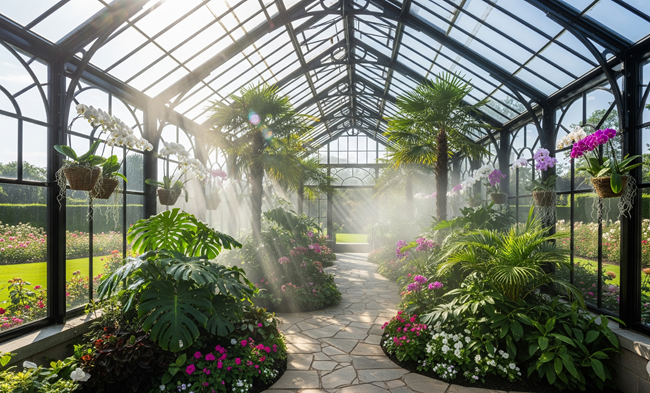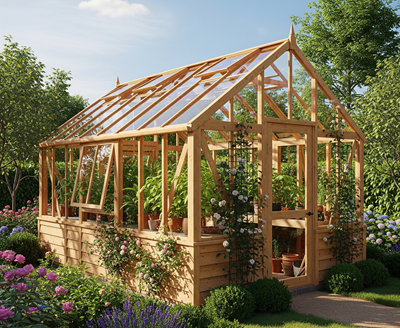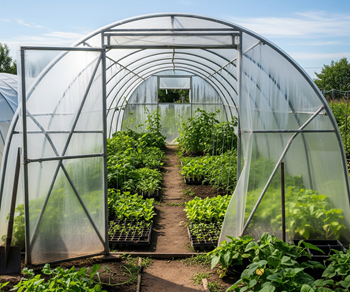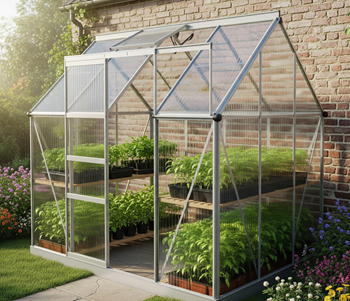
Extending the growing season and heightened control over environmental conditions are just two of the reasons a horticulturist may wish to own a greenhouse. Greenhouses can be either attached or standalone structures. There are many different styles of greenhouses available and each can be constructed from a variety of materials. Aside from aesthetics, the materials used to construct a greenhouse will determine how energy efficient it will be. It will also determine the greenhouse’s longevity and resistance to weather conditions. Regardless of the style, every greenhouse consists of two major components: the frame and the glazing material. To gain some insight into the advantages and disadvantages of each, a potential greenhouse owner should take a closer look at some of the more frequently used framing and glazing materials.
Framing

The framing of a greenhouse refers to the structural part which holds the glazing material and is usually the backbone of the entire structure. Most greenhouses have some sort of foundation to which the frame is connected and secured. Common framing materials are wood, plastic, aluminum and steel.
Wood
Many homemade greenhouse structures use wood as the framing material. Wood is generally inexpensive and easy to customize which makes it a popular choice for do-it-yourself greenhouses. Treated lumber should always be used in greenhouse construction because the wood needs to be protected from humidity damage. Greenhouses tend to have warmer temperatures and a higher relative humidity than that of the ambient air and this can quickly cause damage to or rot untreated wood. Even with treated lumber, the constant exposure to humidity tends to make wood a less practical greenhouse framing material than plastic or metal.

Plastic
Plastic is a commonly used framing material for greenhouses, especially for do-it-yourself hoop houses. Gardeners building this type of greenhouse will utilize PVC pipes as the ribs. Plastic is generally more expensive than wood for a do-it-yourself greenhouse, but will last longer and will better withstand the temperatures and humidity associated with greenhouse environments. Some plastics are UV resistant and others are not. Plastics with UV protection are better suited for greenhouse applications and will last much longer than those without UV protection.
Aluminum
Many small, hobby greenhouses utilize stamped aluminum for the framing material. These types of greenhouses are not necessarily built to last a lifetime, but the aluminum frame will withstand the temperature fluctuations and the humidity commonly found in greenhouse environments. A higher quality, but more expensive, option is the extruded aluminum framing commonly used in high end greenhouses. This framing material is built to last a lifetime and, although more expensive, is worth the investment for any serious horticulturist.
Steel
Galvanized steel is another commonly used framing material for greenhouses. As with the aluminum, there are different grades of quality with galvanized steel frames. Generally speaking, the hobby-style greenhouses are constructed with thinner framing material and will not last as long or withstand as much abuse as the thicker, higher quality steel framing designed for permanent greenhouses.
Snow and Wind Loads
The framing material is generally what determines the strength of the greenhouse structure and whether or not the greenhouse will meet the snow and wind load building code requirements. Most hobby greenhouses will not meet heavy wind or snow load requirements; however, these greenhouses also do not require permits because they are not considered permanent structures. Permanent greenhouse structures are treated much like other buildings when it comes to meeting building code requirements. In locations where snow loads or wind loads are extreme, additional bracing or advanced technological designs can be used to create additional strength in the greenhouse’s frame. In order to meet the building code requirements, many of the newer greenhouses utilize sophisticated engineering designs, like the scissor truss, to strengthen the frame.
Glazing
Greenhouse glazing is the transparent material that lets sun reach the plants, but still protects the environment within the structure. Many different types of glazing materials can be used and each has its own unique advantages and disadvantages.
Polyethylene Film
Polyethylene film is commonly used on large hoop houses and/or temporary cold frames. Polyethylene film is the least expensive of the greenhouse glazing options and is also very customizable. It can be cut and shaped easily, making it a popular choice for homemade greenhouse frames or do-it-yourself greenhouses. Perhaps the biggest disadvantages of polyethylene film are its short life span (1-4 years) and its very low R-value. A low R-value equates to higher heating costs, especially during winter months. Many gardeners who use polyethylene film will add a second layer to increase the thermal properties. Unfortunately, this doesn’t increase the life span and doubles the cost of the glazing material.
Polycarbonate (Corrugated)

Another commonly used glazing material is corrugated polycarbonate. The advantages of corrugated polycarbonate include high light transmittance, high impact resistance and relatively low cost. Polycarbonate, like polyethylene film, has a very low R-value. Again, this means higher heating costs. Corrugated polycarbonate also scratches very easily which will greatly reduce the light transmission.
Polycarbonate (Multi-Wall)
The glazing material that offers the best all-around value for home hobbyists is multi-wall polycarbonate. Multi-wall polycarbonate is very durable and offers a higher insulation value. This is due to the air pocket created between the walls of the material. Higher energy efficiency equates to lower heating costs, especially if the greenhouse is operational during the winter months. Another advantage of multi-wall polycarbonate is its life expectancy. Most polycarbonate materials are warrantied for ten years and have a 15+ year life expectancy. Due to its higher energy efficiency, durability, longevity and overall value, multi-walled polycarbonate is becoming the most popular choice for a greenhouse glazing material. It should be noted that multi-wall polycarbonate has also become the most popular choice for retrofitting older greenhouses to increase energy efficiency and productivity.
Glass (Single Pane)
Glass was the old standard for greenhouse glazing material. Perhaps the largest advantage of a glass greenhouse is aesthetics. In other words, a glass greenhouse simply looks great. Another advantage of a glass greenhouse is longevity. Glass greenhouses are designed to last 25+ years and can easily achieve this as long as it isn’t struck with a hard object. Unfortunately, glass greenhouses have a low impact resistance (even thick greenhouse glass is prone to cracks or breakage). Glass glazing material also tends to cost much more than polycarbonate material. Single pane glass has a low R-Value; it is comparable to polyethylene film. In other words, a single pane glass greenhouse will not be very energy efficient when it comes to heating. However, single pane glass offers the highest light transmission rating of any greenhouse glazing option.
Glass (Double Pane)
The most energy efficient and most expensive glazing material option is double pane glass. There is no doubt about it; you get what you pay for: double pane glass glazing is the best of the best when it comes to greenhouse glazing materials. It looks fantastic and its energy efficiency will offset its high price tag over a long period of time. Serious gardeners who value aesthetics and who want to grow year-round should consider double pane glass as their glazing material. Like single pane glass, double pane glass greenhouses are built to last 25+ years and can be considered a permanent structure; however, they still have a low impact resistance. Due to the second layer of glass, double pane glass has a slightly lower light transmission rating than single pane glass, but offers a higher light diffusion rating.
When shopping for or designing a greenhouse, a gardener has an abundance of options from which to choose. Whether you are planning to build your own greenhouse or to purchase one, a better understanding of the materials used will help you make the decision that best suits your needs. For more permanent structures, it is always important to look into the building code requirements before purchasing or beginning the process of constructing your greenhouse. The framing and glazing materials of a greenhouse are both very important factors to consider when making your final decision regarding a greenhouse project. It is important to become informed and make an educated decision. That way when your greenhouse is complete you can rest assured that you made the right decision and your time and energy can be spent doing what all greenhouse growers want to do most: cultivate plants.
Eric Hopper resides in Michigan’s beautiful Upper Peninsula where he enjoys gardening and pursuing sustainability.



Comment here